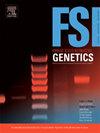从全基因组测序中发现前所未有的y - snv雄性相对分化。
IF 3.1
2区 医学
Q2 GENETICS & HEREDITY
引用次数: 0
摘要
法医 Y-STR 分析的主要局限是识别男性血统而非男性个体,而快速变异 Y-STR(RM Y-STR)的发现和应用正在解决这一问题。与法医学中使用的标准 Y-STR 相比,RM Y-STR 的变异率更高,因此能显著提高区分男性亲属的能力。然而,一些男性亲属--尤其是近亲--仍然无法区分。鉴于前两次 RM Y-STR 搜索的设计和执行发现了目前已知的 26 条 RM Y-STR,未来的搜索不太可能在很大程度上增加 RM Y-STR 的数量。为了解决利用 Y 染色体分析区分男性亲属这一持续存在的法医学难题,本研究探索了另一种方法:通过全基因组测序(WGS)获得 Y 染色体单核苷酸变异(Y-SNVs)。为了评估全基因组测序技术在区分近亲和远亲男性方面的可行性,我们对属于三个深根血统的 24 个男性个体的 DNA 样本进行了测序,其中包括 12 对父子和 72 对相隔 8-15 个减数世的远亲男性。在总共分析的 76 次减数分裂中,每个样本产生的约 25 Mbp Y 染色体序列中发现了 90 个男性亲属差异 Y-SNV。如果同时考虑来自 Yfiler Plus、RMplex 和 WGS 分析的 Y-STR,共观察到 141 个男性相对差异 Y 染色体突变。在 12 对父子中,有 6 对(50%)通过一个或多个 Y-SNV 进行了分化,9 对(75%)通过 WGS 和 CE 方法进行了分化。所有 72 对男性远亲都通过 Y-SNV 和 RM Y-STRs 进行了区分。总体而言,与 RMplex 相比,WGS 在父子配对中观察到的突变数量增加了 1.7 倍,在远亲男性中观察到的突变数量增加了 4 倍。我们的原理验证研究证明了:(i) Y-SNV 标记和 WGS 技术在区分男性近亲和远亲方面的可行性和高价值;(ii) 相对于以前使用的 RM Y-STR 标记和 RMplex 方法,WGS 的 Y-SNV 性能更优;(iii) 结合这两种标记类型和方法可实现更强的男性亲属区分。我们设想,在没有常染色体 STR 图谱、标准 Y-STR 和 RM Y-STR 分析无法将嫌犯与其父系男性亲属区分开来的情况下,WGS 将成为根据 Y 染色体信息最大限度区分男性亲属的首选方法。本文章由计算机程序翻译,如有差异,请以英文原文为准。
Unprecedented male relative differentiation with Y-SNVs from whole genome sequencing
The principal limitation of forensic Y-STR analysis, which identifies a male lineage rather than an individual man, is being addressed by the discovery and application of rapidly mutating Y-STRs (RM Y-STRs). Due to their higher mutation rates compared to standard Y-STRs used in forensics, RM Y-STRs significantly enhance the ability to differentiate between male relatives. However, some male relatives – particularly closely related ones – remain indistinguishable. Given the design and execution of the two previous RM Y-STR searches that discovered the 26 currently known RM Y-STRs, it is unlikely that future searches will largely increase the number of RM Y-STRs. To address the ongoing forensic challenge of differentiating between male relatives using Y chromosome analysis, this study explorers an alternative approach: Y-chromosomal singe nucleotide variants (Y-SNVs) obtained via whole genome sequencing (WGS). To assess the feasibility of the WGS technology in differentiating closely and distantly related males, we sequenced DNA samples of 24 male individuals belonging to three deep-rooted pedigrees, covering 12 father-son pairs and 72 pairs of distant male relatives separated by 8–15 meioses. Among the 76 meioses analyzed in total, 90 male relative-differentiating Y-SNVs were identified across the approximately 25 Mbp Y chromosome sequence generated per sample. A total of 141 male relative-differentiating Y chromosome mutations were observed when also considering Y-STRs from Yfiler Plus, RMplex, and WGS analyses. Of the 12 father-son pairs, six (50 %) were differentiated by one or more Y-SNVs, and 9 (75 %) with WGS and CE methods combined. All of the 72 pairs of distant male relatives were distinguished both through Y-SNVs and RM Y-STRs. Overall, when compared to RMplex, WGS yielded a 1.7-fold increase in the number of observed mutations in father-son pairs and a 4-fold increase in distantly related males. Our proof-of-principle study demonstrates (i) the feasibility and high value of Y-SNV markers and WGS technology in differentiating both close and distant male relatives; (ii) the superior performance of Y-SNVs from WGS relative to the previously used RM Y-STR markers and RMplex method; and (iii) the enhanced male relative differentiation achieved by combining both marker types and methods. We envision WGS as the method of choice for maximizing male relative differentiation based on Y chromosome information in high-profile criminal cases with male suspects where no autosomal STR profiles are available and where standard Y-STR and RM Y-STR analyses fail to distinguish the suspect from his male paternal relatives.
求助全文
通过发布文献求助,成功后即可免费获取论文全文。
去求助
来源期刊
CiteScore
7.50
自引率
32.30%
发文量
132
审稿时长
11.3 weeks
期刊介绍:
Forensic Science International: Genetics is the premier journal in the field of Forensic Genetics. This branch of Forensic Science can be defined as the application of genetics to human and non-human material (in the sense of a science with the purpose of studying inherited characteristics for the analysis of inter- and intra-specific variations in populations) for the resolution of legal conflicts.
The scope of the journal includes:
Forensic applications of human polymorphism.
Testing of paternity and other family relationships, immigration cases, typing of biological stains and tissues from criminal casework, identification of human remains by DNA testing methodologies.
Description of human polymorphisms of forensic interest, with special interest in DNA polymorphisms.
Autosomal DNA polymorphisms, mini- and microsatellites (or short tandem repeats, STRs), single nucleotide polymorphisms (SNPs), X and Y chromosome polymorphisms, mtDNA polymorphisms, and any other type of DNA variation with potential forensic applications.
Non-human DNA polymorphisms for crime scene investigation.
Population genetics of human polymorphisms of forensic interest.
Population data, especially from DNA polymorphisms of interest for the solution of forensic problems.
DNA typing methodologies and strategies.
Biostatistical methods in forensic genetics.
Evaluation of DNA evidence in forensic problems (such as paternity or immigration cases, criminal casework, identification), classical and new statistical approaches.
Standards in forensic genetics.
Recommendations of regulatory bodies concerning methods, markers, interpretation or strategies or proposals for procedural or technical standards.
Quality control.
Quality control and quality assurance strategies, proficiency testing for DNA typing methodologies.
Criminal DNA databases.
Technical, legal and statistical issues.
General ethical and legal issues related to forensic genetics.

 求助内容:
求助内容: 应助结果提醒方式:
应助结果提醒方式:


